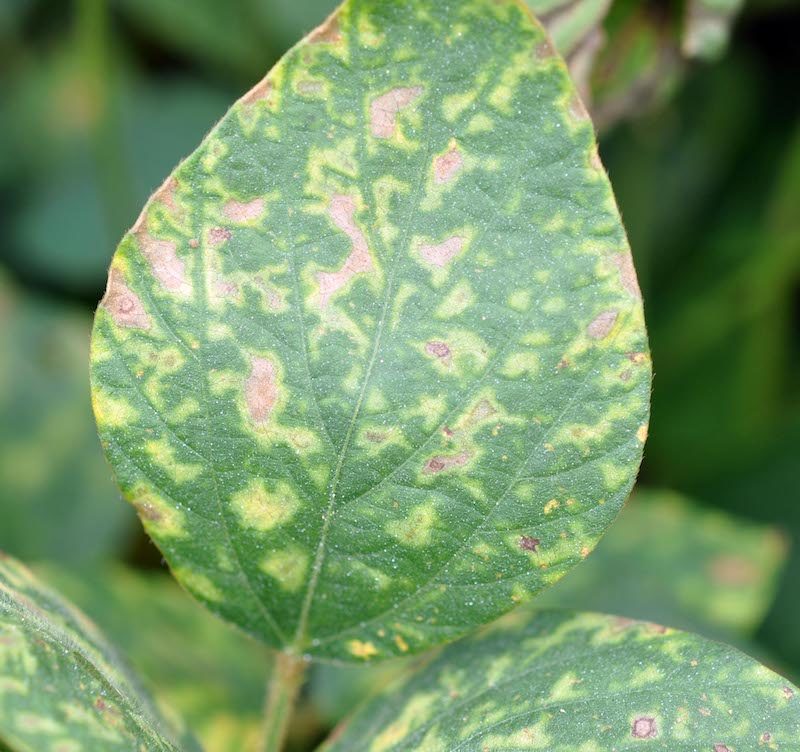With tight profit margins, and other issues affecting farm profitability, some producers that use iLeVO for helping manage sudden death syndrome (SDS) of soybeans have decided to skip including base fungicide treatments in an effort to save money. Another reason for not including a base fungicide seed treatment is because iLeVO contains fluopyram, an SDHI fungicide. Therefore, it should work on our other seedling diseases, such as Rhizoctonia, Pythium, and Phytophthora, right?
The answer to that question is unfortunately no. Fluopyram, like many fungicide active ingredients, has a spectrum of activity, meaning that it is effective on some fungal pathogens and others. Fluopyram is great against Fusarium virguliforme, the causal agent of SDS; however, it does not fair so well on other soilborne pathogens. For example, fluopyram will not have activity against Pythium nor Phytophthora, which are common soilborne diseases under wet conditions. It also will not protect you against Rhizoctonia, which is problematic under hot, somewhat wet conditions.
As an example, we planted a seed treatment trial last year to determine the impact of using iLeVO alone vs iLeVO plus base treatment (vs non-treated seed) on germination, root rot, SDS, plant growth and yield. The experiment was planted at the UIUC Field Lab located in Monmouth, Ill. The study was designed as a random complete block design with 4 replications per treatment. Treatments included iLeVO (0.15 mg a.i. / seed), Base (Evergol energy 0.019 mg / a.i. per seed + Allegiance FL 0.02 mg a.i. / seed), iLeVO + Base and a non-treated control. Plots consisted of 4, 30 inch rows 20 ft in length, and soybean planted at 152,700 plants / A. At planting (May 18, 2018), sorghum infested with F. virgliforme and Rhizoctonia was placed in furrow. Stand counts were taken on May 31 (V1) and 7/3 (R1). For each plot, six seedlings were dug at V6, washed, and roots rated for root rot severity on a 1-5 scale where 1 = no rot and 5 = 80-100% no roots. Plants were dried to constant moisture and weights recorded. All plots were harvested on Oct. 2, 2018, using a Massey 8xP small plot combine, and test weights and yields determined. Data were statistically analyzed. The results of that study are found below.
| Treatment No. | Product | Rate and Units |
14 DAP plants/A Population |
21 DAP plants/A Population |
R1 Rhizoctonia Root Rot Ratings |
R1 grams Plant Weight |
lbs/bu Test Weight |
adj to 15% bu/A Yield |
| 1 | Non-Treated | 42253 B | 39857 B | 4.15 A | 4.8 | 50.9 | 38.4 | |
| 2 |
ILEVO PRECISE S FINISHER 1010 PRO-IZED RED COLORANT |
0.15 MG AI/SEED 65 ML/100 KG 19.6 ML/100 KG |
32452 B | 34195 B | 3.85 A | 4.7 | 58.8 | 38.2 |
| 3 |
EVERGOL ENERGY ALLEGIANCE FL PRECISE S FINISHER 1010 PRO-IZED RED COLORANT |
0.02 MG AI/SEED 0.02 MG AI/SEED 65 ML/100 KG 19.6 ML/100 KG |
69696 A | 69260 A | 2.75 B | 3.6 | 51.7 | 49.2 |
| 4 |
ILEVO EVERGOL ENERGY ALLEGIANCE FL PRECISE S FINISHER 1010 PRO-IZED RED COLORANT |
0.15 MG/AI SEED 0.02 MG/AI SEED 0.02 MG/AI SEED 65 ML/100 KG 19.6 65 ML/100 KG |
66211 A | 69260 A | 2.75 B | 5.1 | 51.6 | 47.8 |
| P > F | 0.0007 | 0.0002 | 0.0002 | 0.53 | 0.39 | 0.057 |
Although skipping your base fungicide treatment may save some money, it may expose you to other issues that can impact your bottom line. Remember that different fungicide active ingredients control different fungal (and oomycete) pathogens differently — try saying that three times fast!
Information on soybean seed treatments and their efficacy against soilborne pathogens is available here.







Post a comment
Report Abusive Comment